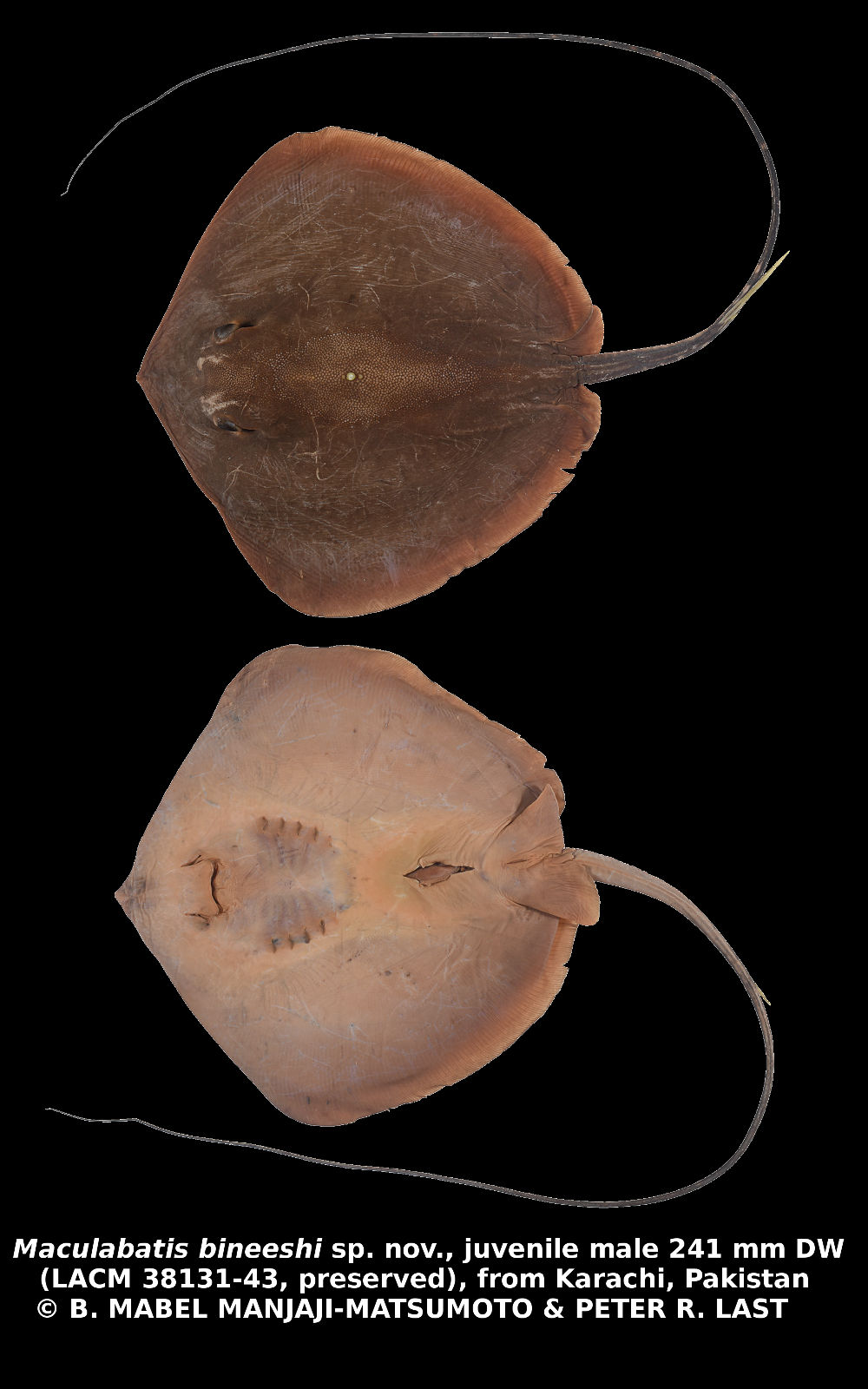Maculabatis bineeshi
Manjaji-Matsumoto & Last, 2016
Classification: Elasmobranchii Myliobatiformes Dasyatidae
Reference of the original description
Two new whiprays, Maculabatis arabica sp. nov. and M. bineeshi sp. nov. (Myliobatiformes: Dasyatidae), from the northern Indian Ocean. Zootaxa, 4144(3), 335–353
Two new whiprays, Maculabatis arabica sp. nov. and M. bineeshi sp. nov. (Myliobatiformes: Dasyatidae), from the northern Indian Ocean. Zootaxa, 4144(3), 335–353
Types
Maculabatis bineeshi
Holotype: LACM: 38131-43; Paratype: CSIRO: H 7998-01 (formerly part of LACM 38130-47); LACM: 38130-47; LACM: 38133-75;
Maculabatis bineeshi
Holotype: LACM: 38131-43; Paratype: CSIRO: H 7998-01 (formerly part of LACM 38130-47); LACM: 38130-47; LACM: 38133-75;
Description :
Citation: Maculabatis bineeshi Manjaji-Matsumoto & Last, 2016: In: Database of modern sharks, rays and chimaeras, www.shark-references.com, World Wide Web electronic publication, Version 12/2025
Please send your images of "Maculabatis bineeshi" to info@shark-references.com

Holotype of Maculabatis bineeshi sp. nov, juvenile male 241 mm DW (LACM 38131-43, preserved), from Karachi, Pakistan © B. MABEL Manjaji-Matsumoto & PETER R. LAST

Holotype of Maculabatis bineeshi sp. nov, juvenile male 241 mm DW (LACM 38131-43, preserved), from Karachi, Pakistan © B. MABEL Manjaji-Matsumoto & PETER R. LAST
Common names
 Short-tail Whipray
Short-tail Whipray
 Short-tail Whipray
Short-tail Whipray
Short Description
Original diagnosis after MANJAJI-MATSUMOTO & LAST, 2016 [24334]: A species of Maculabatis (to at least 66 cm DW) distinguished by a combination of the following characters: disc weakly rhomboidal to suboval, length 93–98% DW; snout moderately elongate with weak apical lobe, snout angle 116–121°; pectoral-fin apices broadly rounded; orbits small to medium-sized, barely protruding; mouth relatively narrow, width 1.2–1.3 in internasal width; distance between first gill slits 2.2–2.5 times internasal distance; distance between fifth gill slits 1.4–1.6 times internasal distance, 28–30% of ventral head length; pelvicfin base broad, 14–15% DW; main suprascapular denticle large, yellowish, broadly ovate, usually followed by smaller subtriangular denticle; secondary denticles developing rapidly, forming broad band extending from interorbit to tail base by 24 cm DW; dorsal disc uniformly light brown, without white spots; pale ventrally with broad, faint and slightly darker lateral margins; tail dark brown to blackish dorsally and white ventrally forward of caudal sting; plain blackish posteriorly or with weak, irregular pale dorsal banding (in young); pectoral-fin radials 127–131; total vertebral count, including synarcual centra 108–114, monospondylous centra 44–46, pre-sting diplospondylous centra 64–69.
Original diagnosis after MANJAJI-MATSUMOTO & LAST, 2016 [24334]: A species of Maculabatis (to at least 66 cm DW) distinguished by a combination of the following characters: disc weakly rhomboidal to suboval, length 93–98% DW; snout moderately elongate with weak apical lobe, snout angle 116–121°; pectoral-fin apices broadly rounded; orbits small to medium-sized, barely protruding; mouth relatively narrow, width 1.2–1.3 in internasal width; distance between first gill slits 2.2–2.5 times internasal distance; distance between fifth gill slits 1.4–1.6 times internasal distance, 28–30% of ventral head length; pelvicfin base broad, 14–15% DW; main suprascapular denticle large, yellowish, broadly ovate, usually followed by smaller subtriangular denticle; secondary denticles developing rapidly, forming broad band extending from interorbit to tail base by 24 cm DW; dorsal disc uniformly light brown, without white spots; pale ventrally with broad, faint and slightly darker lateral margins; tail dark brown to blackish dorsally and white ventrally forward of caudal sting; plain blackish posteriorly or with weak, irregular pale dorsal banding (in young); pectoral-fin radials 127–131; total vertebral count, including synarcual centra 108–114, monospondylous centra 44–46, pre-sting diplospondylous centra 64–69.
Dentition
Teeth small, subequal in upper and lower jaws; cone-shaped with blunt peaks, with prominent horizontal groove. [24334]
Teeth small, subequal in upper and lower jaws; cone-shaped with blunt peaks, with prominent horizontal groove. [24334]
Remarks
shark-references Species-ID=14666;
shark-references Species-ID=14666;





















